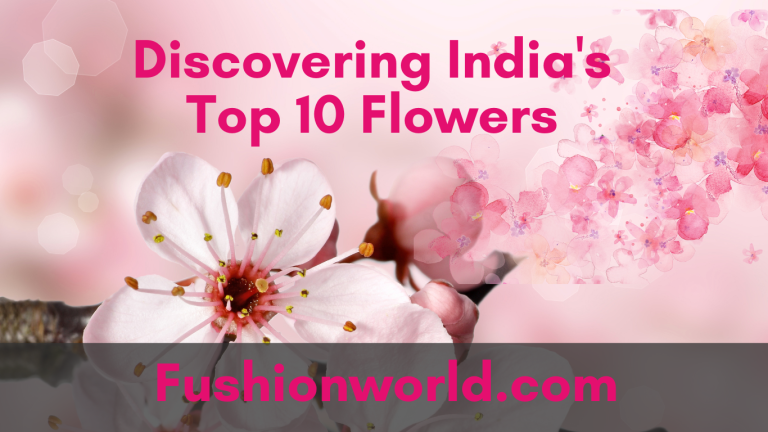Imagine a place where, on one side, you can witness many people with different cultures, languages, beliefs, and thoughts, whereas on the other side, you can enjoy an array of colorful flowers, which makes the place even more lively and dynamic, creating a serene mindset for all the visitors. Certainly, India is one of such places. India is not only rich in culture and language, but also it has a wide range of flowers that are fragrant and colorful. From Kashmir to Kanyakumari, all through the area, each area is known not only for its individuality in beliefs but also for its flowers and foods, which stand apart in their way. Here we are talking about Discovering India’s Top 10 Flowers.
Each flower, soft petals, and fragrance represent its beauty, story, history, and cultural significance. Yes!! That’s India for you. In India, flowers and culture are interwoven together. For every event, you will see the whole place decorated in solid and bold colored flowers, which makes the event even more lively and dynamic and goes deep into the traditionalism of India. Here are the top 10 flowers that grace the diverse tapestry of India:
Let’s Discover India’s Top 10 Flowers.
Lotus (Nelumbo nucifera)

The lotus is not just India’s national flower; it goes beyond that. Its graceful petals floating on calm waters represent purity and enlightenment. The lotus is considered to be a symbol of pure soul.
● Purity and Enlightenment: It symbolizes spiritual purity and enlightenment journey.
● Creation and Cosmology: It is linked to the creation of the universe, as Brahma was believed to be born from the lotus.
● Beauty and Elegance: It is admired for intricate beauty.
● Mandala Symbolism: It symbolises self-realisation.
● Offerings and Rituals: It is used in religious ceremonies and enhances spiritual ambiance.
Marigold (Tagetes erecta)

Marigold is commonly seen in India and widely used and celebrated for its vibrant golden-orange hue. This flower can be seen and used in religious ceremonies on every occasion and in the house. From decorations to garlands, this flower is widely used in all aspects.
● It signifies festivities and celebrations in various cultures and is commonly used during religious and cultural events.
● It is believed to bring good luck and prosperity.
● It is strung into garlands for decorations, adding vibrant hues to religious spaces and events.
● It is integral to Indian cultural traditions, representing warmth, happiness, and positive energy.
Hibiscus (Hibiscus rosa-sinensis)

With its striking red color and many different colors, hibiscus is used widely in homes and for adornments and medical purposes.
● It is admired for its vibrant colors and intricate petals.
● It symbolizes beauty, youth, and feminine qualities.
● It even has many health benefits.
Jasmine (Jasminum)

Jasmine, widely used in perfumes, oils, and religious offerings, represents purity, love, and prosperity and is known for its fragrance.
● It is renowned for its sweet and intoxicating fragrance
● It is linked with love and romantic gestures and is commonly used in wedding ceremonies.
● Holds significance in various cultural traditions and expressions.
Rose (Rosa)

Roses have universal appeal. They are not only ornamental in India but also used in Ayurveda and as offerings in religious ceremonies.
● Universally recognized as a symbol of love and affection.
● Different colors convey various sentiments. Red for love, white for purity, etc. ● Versatile gift for diverse occasions. And represents appreciation, friendship, or condolences.
● Admired for its aesthetic beauty and fragrance.
Sunflower (Helianthus annuus)

The sunflower’s sunny disposition reflects its cheerful presence in Indian fields.
● Symbol of Positivity: It represents positivity and happiness.
● Edible Seeds: Seeds used for edible oil and snacks.
● Heliotropic Nature: Follows the sun’s movement during the day.
● Gardening Favourite: Popular choice for home gardens.
● Cultural Symbolism: Featured in art and literature.
● Botanical Resilience: Adaptable to various climates.
● Versatile Varieties: Numerous species and hybrids.
● Sun-Like Radiance: Golden petals resemble the sun.
Plumeria (Plumeria rubra)

Plumeria is celebrated for its fragrant and exotic flowers. The blossoms are often associated with spirituality and devotion when adorning temple premises and are used in traditional perfumes.
● Fragrance and Exoticism: Known for its fragrant and exotic flowers.
● Cultural and Spiritual Significance: Holds cultural importance in various traditions and is associated with spirituality and devotion.
● Temple Adornments: Often found adorning temple premises and used in religious ceremonies and rituals.
● Symbol of Beauty: Symbolises beauty, charm, and grace. Featured in traditional perfumes.
● Traditional medicine uses parts for various purposes.
Ixora (Ixora coccinea)

Ixora, or “Rangan” in Hindi, is a popular flowering shrub with clusters of small, vibrant flowers.
● Vibrant Clusters: It is known for vibrant, colorful flower clusters.
● Cultural Significance: Holds cultural importance in various traditions and is used in religious ceremonies and decorations.
● Symbol of Strength: Symbolises strength and resilience and thrives in various environmental conditions.
● Fragrance: Some varieties emit a pleasant fragrance and add sensory appeal to gardens.
Orchid (Orchidaceae)

India’s diverse climates provide a conducive environment for a variety of orchids. These exotic and intricate flowers are highly prized for their unique shapes and colors. Orchids hold cultural significance and are associated with love, beauty, and refinement.
● Exotic Beauty: It is known for intricate and exotic flower varieties.
● Cultural and Symbolic Significance: It holds cultural importance in various societies and symbolizes love, beauty, and refinement.
● Global Appeal: Cultivated and cherished worldwide. Represents unity and diversity in various cultures.
● Cultural Association: It is linked to love, fertility, and luxury.
Dahlia (Dahlia)

Although not native to India, Dahlias have gained popularity for their diverse forms and colors. These vibrant blooms are often cultivated in gardens and flower shows, showcasing their beauty and contributing to the country’s rich floral tapestry.
● Diverse Blooms: It is known for a wide variety of flower shapes and colors
● Symbol of Elegance: Symbolises elegance and inner strength and is often associated with dignity and grace.
● Cultural Significance: Holds cultural importance in various societies and is represented in art and literature.
FAQ:
What is the most popular flower in India?
The lotus is the most popular flower in India.
Which flower has the highest demand in India?
Lotus, lily, and jasmine are the flowers in the highest demand.
What is India’s national flower?
Lotus.
Which flower is rare in India?
Neelakurinji blooms once every twelve years and is considered the most occasional flower in India.
What is the king of flowers in India?
Rose is considered the king of flowers.
Which flower Colour is rare?
Blue is one of the rarest colors.
Is rose popular in India?
Yes, it is admired in India.
Conclusion:
As said before, flowers are not just meant for admiration in India; it goes beyond that, where flowers and tradition are interwoven and known for their cultural and medical significance.
Flowers in India light up the country with their deep and vibrant colors and symbolize beauty, peace, etc. These flowers aren’t just pretty; they’re an essential part of people’s lives, culture, and traditions, which makes them unique.

